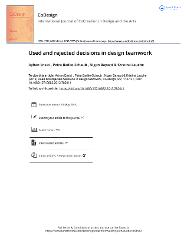| dc.contributor.author | Ensici, Ayhan | |
| dc.contributor.author | Badke-Schaub, Petra | |
| dc.contributor.author | Bayazit, Nigan | |
| dc.contributor.author | Lauche, Kristina | |
| dc.date.accessioned | 2019-06-27T08:03:35Z | |
| dc.date.available | 2019-06-27T08:03:35Z | |
| dc.date.issued | 2013 | |
| dc.identifier.issn | 1571-0882 | en_US |
| dc.identifier.uri | https://hdl.handle.net/20.500.12469/810 | |
| dc.identifier.uri | https://doi.org/10.1080/15710882.2013.782411 | |
| dc.description.abstract | Decision making in design requires careful consideration as any inaccuracies or faults can have serious consequences for the producer the user and/or the competitiveness of the company. Research investigating decision making in design so far has mainly focused on the selection of decisions as part of technical choices and classical optimisation problems. In recent years further research has been started to discover the characteristics of successful decision making in industry. These later mostly single case studies shed light on some general influences on decision making but so far have not identified different relevant patterns of decision-making processes in design teams which are influential on the result and the process of decision making such as the constituents of rejected decisions. The research study reported here was initiated to further analyse the components of decision-making processes in teams with special emphasis on the question of how decisions develop during the design process. For example what happens to rejected decisions in the course of the design process? The observed processes should be analysed in detail by assessing all utterances in an interaction protocol which can be used as indicators of underlying cognitive processes in decision making | en_US] |
| dc.description.abstract | this research approach is usually called protocol analysis. In this experimental study using protocol analysis rejected decisions were compared against those that were chosen to be used in designing the final outcome. The findings show how the designers develop the solution space and illustrate the analysis of decisions as a promising approach to analyse both the individual cognitive process and the contribution of the individual to the decision-making process in design teams. | en_US] |
| dc.language.iso | eng | en_US |
| dc.publisher | Taylor & Francis Ltd | en_US |
| dc.rights | info:eu-repo/semantics/openAccess | en_US |
| dc.subject | Design process | en_US |
| dc.subject | Teamwork | en_US |
| dc.subject | Decision making | en_US |
| dc.subject | Protocol analysis | en_US |
| dc.title | Used and rejected decisions in design teamwork | en_US |
| dc.type | article | en_US |
| dc.identifier.startpage | 113 | en_US |
| dc.identifier.endpage | 131 | |
| dc.relation.journal | Codesign-International Journal Of Cocreation In Design And The Arts | en_US |
| dc.identifier.issue | 2 | |
| dc.identifier.volume | 9 | en_US |
| dc.department | Fakülteler, Sanat ve Tasarım Fakültesi, Endüstri Ürünleri Tasarımı Bölümü | en_US |
| dc.identifier.wos | WOS:000319376700003 | en_US |
| dc.identifier.doi | 10.1080/15710882.2013.782411 | en_US |
| dc.identifier.scopus | 2-s2.0-84878654069 | en_US |
| dc.institutionauthor | Ensici, Ayhan | en_US |
| dc.institutionauthor | Bayazit, Nigan | en_US |
| dc.relation.publicationcategory | Makale - Uluslararası Hakemli Dergi - Kurum Öğretim Elemanı | en_US |
















